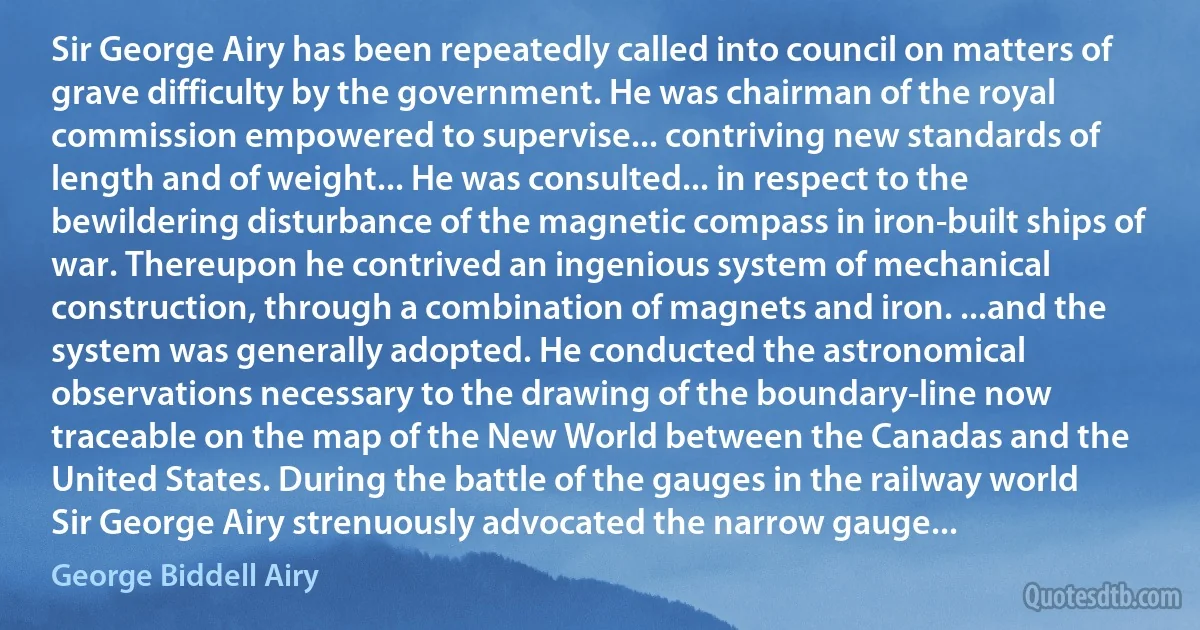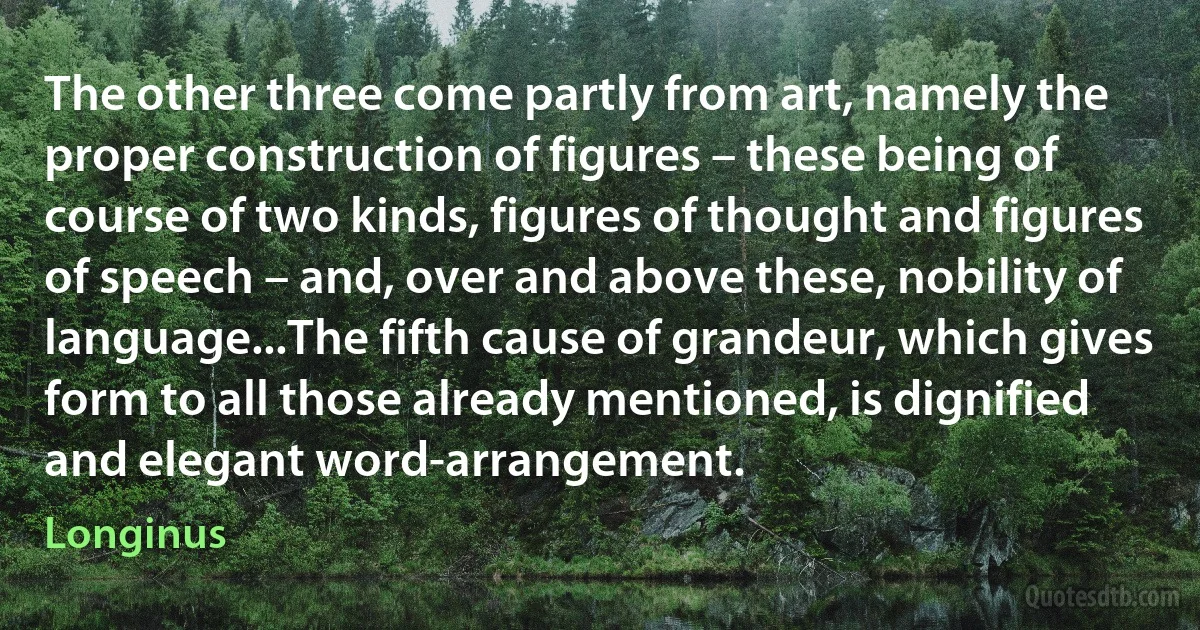Construction Quotes - page 21
But giving the provisions the very worse construction, what does it amount to? I answer - It is a downright disability laid upon the slaveholding States; one which deprives those States of two-fifths of their natural basis of representation. A black man in a free State is worth just two-fifths more than a black man in a slave State, as a basis of political power under the Constitution. Therefore, instead of encouraging slavery, the Constitution encourages freedom by giving an increase of "two-fifths” of political power to free over slave States. So much for the three-fifths clause; taking it at is worst, it still leans to freedom, not slavery; for, be it remembered that the Constitution nowhere forbids a coloured man to vote.

Frederick Douglass
His talent was as natural as the pattern that was made by the dust on a butterfly's wings. At one time he understood it no more than the butterfly did and he did not know when it was brushed or marred. Later he became conscious of his damaged wings and of their construction and he learned to think and could not fly any more because the love of flight was gone and he could only remember when it had been effortless.

Ernest Hemingway
The West German revanchists and militarists are using the peace-loving position of the USSR and the member-states of the Warsaw Pact on the resolution of German question, so as to inflict harm on the German Democratic Republic through subversive activity and the illegal recruitment of citizens of the German Democratic Republic. For this, they primarily use the open border in Berlin. In the interests of the peaceful work and construction by the citizens of the German Democratic Republic and of the member-states of the Warsaw Pact, it is necessary to stop the illegal recruitment and other hostile measures. Therefore, we propose that the member-states of the Warsaw Pact agree, in the interests of the cessation of the subversive activity, to implement control along the borders of the German Democratic Republic, including the borders in Berlin, comparable to the control along the state borders of the Western powers.

Walter Ulbricht
It is to the Italian astronomer, forced in old age by the Inquisition to turn aside from the more dangerous study of the machinery of the heavens, that we owe the first exposition of many of the problems of mechanics and statics, published... in 1638. Not only did Galileo put together whatever the sixteenth century had learned in the sciences affecting building construction, but from his study of the bending strength of a beam there dates a new branch of science-the theory of the strength of materials.

Galileo Galilei
Geis is a pain, Sharrow; the guy has a kind of charming facade but basically he's a social inadequate whose real place in life is out mugging pensioners and cheating and beating on his girlfriends, and if he had three more names and been raised in a rookery in the The Meg rather than the nursery at house Tzant, that's exactly what he would be doing. Instead he jumps out of the commercial equivalent of dark allies, strips companies and fucks their employees. He's got no idea how real people work so he plays the market instead; he's a rich kid who thinks the banks and courts and Corps are his construction set and he doesn't want anybody else to play. He wants you the way he wants a sexy company, as a bauble, a scalp, something to display. Never get beholden to people like that, they'll piss on you and then charge irrigation fees.

Iain Banks
I had made up my mind to find that for which I was searching even if it required the remainder of my life. After innumerable failures I finally uncovered the principle for which I was searching, and I was astounded at its simplicity. I was still more astounded to discover the principle I had revealed not only beneficial in the construction of a mechanical hearing aid but it served as well as means of sending the sound of the voice over a wire. Another discovery which came out of my investigation was the fact that when a man gives his order to produce a definite result and stands by that order it seems to have the effect of giving him what might be termed a second sight which enables him to see right through ordinary problems. What this power is I cannot say; all I know is that it exists and it becomes available only when a man is in that state of mind in which he knows exactly what he wants and is fully determined not to quit until he finds it.

Alexander Graham Bell
How then could such a figure, seemingly the least ‘historical' of philosophers, provide thinkers concerned with transformation, novelty, the event, with the wherewithal to advance radical projects of thought? Why is Spinoza repeatedly be invoked in the most urgent of political and ideological polemics? How could a philosophy turned toward the eternity of being (an ontology) link up with the attempt to understand the collective construction of a common political space and the sometimes catastrophic incursion of worldly events?

Baruch Spinoza
Cultures may be classed into three types: tool-using cultures, technocracies, and technopolies. ...until the seventeenth century, all cultures were tool-users. ...the main characteristic of all tool-using cultures is that their tools were largely invented to do two things: to solve specific and urgent problems of physical life, such as in the use of waterpower, windmills, and the heavy-wheeled plow; or to serve the symbolic world of art, politics, myth, ritual, and religion, as in the construction of castles and cathedrals and the development of the mechanical clock. In either case, tools (...were not intended to attack) the dignity and integrity of the culture into which they were introduced. With some exceptions, tools did not prevent people from believing in their traditions, in their God, in their politics, in their methods of education, or in the legitimacy of their social organization...

Neil Postman
...In the United States and similar multicultural societies, media representations of women differ depending on varying combinations of race, gender identity, ethnicity, class and citizenship status. The white middle-class heterosexual woman holding US citizenship is held up as an ideal type for women from other groups. This is an ideal, a representation, a social construction and not an actual category of people...

Patricia Hill Collins
As for "wattle and daub" I could wish that it had never been invented. The more it saves in time and gains in space, the greater and the more general is the disaster that it may cause; for it is made to catch fire, like torches. It seems better, therefore, to spend on walls of burnt brick, and be at expense, than to save with "wattle and daub," and be in danger. And, in the stucco covering, too, it makes cracks from the inside by the arrangement of its studs and girts. For these swell with moisture as they are daubed, and then contract as they dry, and by their shrinking cause the solid stucco to split. But since some are obliged to use it either to save time or money, or for partitions on an unsupported span, the proper method of construction is as follows. Give it a high foundation so that it may nowhere come in contact with the broken stone-work composing the floor...

Vitruvius
We have such exorbitant eyes, that on seeing the smallest arc, we complete the curve, and when the curtain is lifted from the diagram which it seemed to veil, we are vexed to find that no more was drawn, than just that fragment of an arc which we first beheld. We are greatly too liberal in our construction of each other's faculty and promise. Exactly what the parties have already done, they shall do again; but that which we inferred from their nature and inception, they will not do. That is in nature, but not in them.

Ralph Waldo Emerson
Dr. Plot, in his 'Natural History of Oxfordshire.' (1677) attributed to a 'plastic virtue latent in the earth' the origin of fossil shells and fishes; and Lister, to his accurate account of British shells, in 1678, added the fossil species, under the appellation of turbinated and bivalve stones. 'Either,' said he, 'these were terriginous, or if otherwise, the animals they so exactly represent have become extinct. This writer appears to have been the first who was aware of the continuity over large districts of the principal groups of strata in the British series, and who proposed the construction of regular geological maps.

Charles Lyell
This is the reason for the clear and unsparing summons to fight Bolshevism and international Jewry, whose race-destroying activities we have sufficiently experienced on our own people. Therefore, the alliance with all similar-minded Nations who, like Germany, are not willing to allow their strength, dedicated to construction and peaceful work at home, to be disrupted by alien ideologies as by parasites of a foreign race.

Erich Raeder
There is a sense, and a very exciting sense, in which art is moral. When Stendhal says a good picture is nothing but a construction in ethics, one recognises a truth about art which opens up vistas that are at the same time liberating and terrifying. The ethics of art are terrifying because real art by increasing our knowledge of ourselves increases in exactly the same proportion the ethical commitment.

Patrick Swift
The deeper question that lies behind the above banalities is whether the rules of baseball are similar to or radically different from the rules of science. Clearly they are radically different. Like the rules of chess and bridge, the rules of baseball or made by humans. But the rules of science are not. They are discovered by observation, reasoning, and experiment. Newton didn't invent his laws of gravity except in the obvious sense that he thought of them and wrote them down. Biologists didn't "construct” the DNA helix; they observed it. The orbit of Mars is not a social construction. Einstein did not make up E=mc the way game rules are made up. To see rules of science as similar to baseball rules, traffic rules, or fashions in dress is to make a false analogy that leads nowhere.

Martin Gardner
We succeeded to take our last steps to freedom in conditions of relative peace. We commit ourselves to the construction of a complete, just and lasting peace.
We have triumphed in the effort to implant hope in the breasts of the millions of our people. We enter into a covenant that we shall build the society in which all South Africans, both black and white, will be able to walk tall, without any fear in their hearts, assured of their inalienable right to human dignity - a rainbow nation at peace with itself and the world.

Nelson Mandela
I will clarify a distinction that I consider fundamental to political ecology. I shall distinguish the environment as commons from the environment as resource. On our ability to make this particular distinction depends not only the construction of a sound theoretical ecology, but also - and more importantly - effective ecological jurisprudence.

Ivan Illich
We cannot forget what Lenin said about our great construction, which in large part depends on our succeeding in delaying the war with the capitalist countries. This war is inevitable, but it can be delayed until the proletarian revolution ripens in Europe, or until the colonial revolutions break out, or, finally, until the capitalists fight among themselves for the division of the colonies.

Joseph Stalin
The revolution in views of programming started by Dijkstra's iconoclasm led to a movement known as structured programming, which advocated a systematic, rational approach to program construction. Structured programming is the basis for all that has been done since in programming methodology, including object-oriented programming. As the first book on the topic [Structured Programming by Dijkstra, Ole-Johan Dahl, and Tony Hoare] shows, structured programming is about much more than control structures and the goto. Its principal message is that programming should be considered a scientific discipline based on mathematical rigor.

Edsger W. Dijkstra



